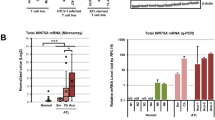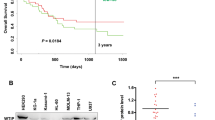Abstract
The WT1 gene is overexpressed in human primary leukemia and a wide variety of solid cancers. The WT1 gene is alternatively spliced at two sites, yielding four isoforms: 17AA(+)KTS(+), 17AA(+)KTS(−), 17AA(−)KTS(+), and 17AA(−)KTS(−). Here, we showed that 17AA(+)WT1-specific siRNA induced apoptosis in three WT1-expressing leukemia cell lines (K562, HL-60, and Kasumi-1), but not in WT1-non-expressing lymphoma cell line (Daudi). 17AA(+)WT1-specific siRNA activated caspase-3 and -9 in the intrinsic apoptosis pathway but not caspase-8 in the extrinsic one. On the other hand, 17AA(−)WT1-specific siRNA did not induce apoptosis in the three WT1-expressing cell lines. The apoptosis was associated with activation of proapoptotic Bax, which was activated upstream of the mitochondria. Constitutive expression of 17AA(+)WT1 isoforms inhibited apoptosis of K562 leukemia cells induced by apoptosis-inducing agents, etoposide and doxorubicin, through the protection of mitochondrial membrane damages, and DNA-binding zinc-finger region of 17AA(+)WT1 isoform was essential for the antiapoptotic functions. We further studied the gene(s) whose expression was altered by the expression of 17AA(+)WT1 isoforms and showed that the expression of proapoptotic Bak was decreased by the expression of 17AA(+)KTS(−)WT1 isoform. Taken together, these results indicated that 17AA(+)WT1 isoforms played antiapoptotic roles at some points upstream of the mitochondria in the intrinsic apoptosis pathway.
This is a preview of subscription content, access via your institution
Access options
Subscribe to this journal
Receive 50 print issues and online access
$259.00 per year
only $5.18 per issue
Buy this article
- Purchase on Springer Link
- Instant access to full article PDF
Prices may be subject to local taxes which are calculated during checkout








Similar content being viewed by others
References
Algar EM, Khromykh T, Smith SI, Blackburn DM, Bryson GJ, Smith PJ . (1996). Oncogene 12: 1005–1014.
Call KM, Glaser TM, Ito CY, Buckler AJ, Pelletier J, Haber DA et al. (1990). Cell 60: 509–520.
Davies JA, Ladomery M, Hohenstein P, Michael L, Shafe A, Spraggon L et al. (2004). Hum Mol Genet 13: 235–246.
Davies RC, Calvio C, Bratt E, Larsson SH, Lamond AI, Hastie ND . (1998). Genes Dev 12: 3217–3225.
Drummond IA, Madden SL, Rohwer-Nutter P, Bell GI, Sukhatme VP, Rauscher III FJ . (1992). Science 257: 674–678.
Englert C, Maheswaran S, Garvin AJ, Kreidberg J, Haber DA . (1997). Cancer Res 8: 1429–1434.
Gashler AL, Bonthouron DT, Madden SL, Rauscher III FJ, Collins T, Sukhatme VP . (1992). Proc Natl Acad Sci USA 89: 10984–10988.
Goodyer P, Dehbi M, Torban E, Bruening W, Pelletier J . (1995). Oncogene 10: 1125–1129.
Harada Y, Nonomura N, Nishimura K, Tamaki H, Takahara S, Miki T et al. (1999). Mol Urol 3: 357–364.
Harrington MA, Konicek B, Song A, Xia XL, Fredericks WJ, Rauscher III FJ . (1993). J Biol Chem 268: 21271–21275.
Herzer U, Crocoll A, Barton D, Howells N, Englert C . (1999). Curr Biol 9: 837–840.
Hubinger G, Schmid M, Linortner S, Manegold A, Bergmann L, Maurer U . (2001). Exp Hematol 10: 1226–1235.
Inoue K, Sugiyama H, Ogawa H, Nakagawa M, Yamagami T, Miwa H et al. (1994). Blood 84: 3071–3079.
Inoue K, Tamaki H, Ogawa H, Oka Y, Soma T, Tatekawa T et al. (1998). Blood 91: 2969–2976.
Kreidberg JA, Sariola H, Loring JM, Maeda M, Pelletier J, Housman D et al. (1993). Cell 74: 679–691.
Larsson SH, Charlieu JP, Miyagawa K, Engelkamp D, Rassoulzadegan M, Ross A et al. (1995). Cell 81: 391–401.
Li H, Oka Y, Tsuboi A, Yamagami T, Miyazaki T, Yusa S et al. (2003). Int J Hematol 77: 463–470.
Loeb DM, Evron E, Patel CB, Sharma PM, Niranjan B, Buluwela L et al. (2001). Cancer Res 61: 921–925.
Loeb DM, Summers JL, Burwell EA, Korz D, Friedman AD, Sukumar S . (2003). Leukemia 17: 965–971.
Mayo MW, Wang CY, Drouin SS, Madrid LV, Marshall AF, Reed JC et al. (1999). EMBO J 18: 3990–4003.
Miyoshi Y, Ando A, Egawa C, Taguchi T, Tamaki Y, Tamaki H et al. (2002). Clin Cancer Res 8: 1167–1171.
Niksic M, Slight J, Sanford JR, Caceres JF, Hastie ND . (2004). Hum Mol Genet 13: 463–471.
Oji Y, Inohara H, Nakazawa M, Nakano Y, Akahani S, Nakatsuka S et al. (2003a). Cancer Sci 94: 523–529.
Oji Y, Miyoshi S, Maeda H, Hayashi S, Tamaki H, Nakatsuka S et al. (2002). Int J Cancer 100: 297–303.
Oji Y, Miyoshi Y, Koga S, Nakano Y, Ando A, Nakatsuka S et al. (2003b). Cancer Sci 94: 606–611.
Oji Y, Nakamori S, Fujikawa M, Nakatsuka S, Yokota A, Tatsumi N et al. (2004a). Cancer Sci 95: 583–587.
Oji Y, Ogawa H, Tamaki H, Oka Y, Tsuboi A, Kim EH et al. (1999). Jpn J Cancer Res 90: 194–204.
Oji Y, Suzuki T, Nakano Y, Maruno M, Nakatsuka S, Jomgeow T et al. (2004b). Cancer Sci 95: 822–827.
Oji Y, Yamamoto H, Nomura M, Nakano Y, Ikeba A, Nakatsuka S et al. (2003c). Cancer Sci 94: 712–717.
Oji Y, Yano M, Nakano Y, Abeno S, Nakatsuka S, Ikeba A et al. (2004c). Anticancer Res 24: 3103–3108.
Osaka M, Koami K, Sugiyama T . (1997). Int J Cancer 72: 696–699.
Reynolds PA, Smolen GA, Palmer RE, Sgroi D, Yajnik V, Gerald WL et al. (2003). Genes Dev 17: 2094–2107.
Shimizu S, Eguchi Y, Kamiike W, Matsuda H, Tsujimoto Y . (1996). Oncogene 12: 2251–2257.
Siehl JM, Reinwald M, Heufelder K, Menssen HD, Keilholz U, Thiel E . (2000). Ann Hematol 83: 745–750.
Sugiyama H . (2001). Int J Hematol 73: 177–187.
Tsuboi A, Oka Y, Ogawa H, Elisseeva OA, Tamaki H, Oji Y et al. (1999). Leuk Res 23: 499–505.
Tuna M, Chavez-Reyes A, Tari AM . (2005). Oncogene 24: 1648–1652.
Ueda T, Oji Y, Naka N, Nakano Y, Takahashi E, Koga S et al. (2003). Cancer Sci 3: 271–276.
Wagner KD, Wagner N, Vidal VP, Schley G, Wilhelm D, Schedl A et al. (2002). EMBO J 21: 1398–1405.
Werner H, Re GG, Drummond IA, Sukhatme VP, Rauscher III FJ, Sens DA et al. (1993). Proc Natl Acad Sci USA 90: 5828–5832.
Yamagami T, Ogawa H, Tamaki H, Oji Y, Soma T, Oka Y et al. (1998). Leuk Res 22: 383–384.
Yamagami T, Sugiyama H, Inuoe K, Ogawa H, Tatekawa T, Hirata M et al. (1996). Blood 87: 2878–2884.
Acknowledgements
This work was supported in part by a Grant-in Aid from the Ministry of Education, Science, Sports and Culture and the Ministry of Health, Labour, and Welfare, Japan.
Author information
Authors and Affiliations
Corresponding author
Rights and permissions
About this article
Cite this article
Ito, K., Oji, Y., Tatsumi, N. et al. Antiapoptotic function of 17AA(+)WT1 (Wilms' tumor gene) isoforms on the intrinsic apoptosis pathway. Oncogene 25, 4217–4229 (2006). https://doi.org/10.1038/sj.onc.1209455
Received:
Revised:
Accepted:
Published:
Issue Date:
DOI: https://doi.org/10.1038/sj.onc.1209455
Keywords
This article is cited by
-
Identification of mouse helper epitopes for WT1-specific CD4+ T cells
Cancer Immunology, Immunotherapy (2021)
-
NT157 has antineoplastic effects and inhibits IRS1/2 and STAT3/5 in JAK2V617F-positive myeloproliferative neoplasm cells
Signal Transduction and Targeted Therapy (2020)
-
Loss of Wilms tumor 1 protein is a marker for apoptosis in response to replicative stress in leukemic cells
Archives of Toxicology (2018)
-
RNA binding protein QKI contributes to WT1 mRNA and suppresses apoptosis in ST cells
Genes & Genomics (2017)
-
Deficiency in WT1-targeting microRNA-125a leads to myeloid malignancies and urogenital abnormalities
Oncogene (2016)



